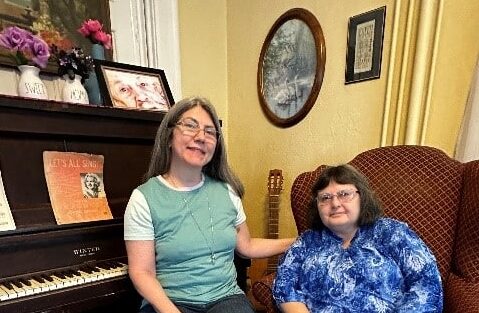
Cindy Guiles’ story is like that of most kids—she lived in Syracuse with her family and went to school, eventually earning her GED as a Syracuse City School District student.
When she was 18, she started living independently, working various community service jobs as a cashier, customer service employee, and volunteered at the Boys and Girls Club. While living on her own and working in the community, she had psychological issues that required professional help.
Cindy said, “I was having trouble and needed mental health support. I had to ask for help.”
She spent some time in a mental health hospital to get the support she needed and then transitioned to a mental health facility where she received psychiatric support services for two and a half years. After leaving the facility, she spent some time in a supportive apartment program before moving into Loretto’s Community Residence Program, where she has lived for the past eight years.
Loretto’s Community Residence Program provides a safe, homelike setting for adults 45 and older and offers support and rehabilitation services for those with psychiatric disabilities. This program has three homes, two in Syracuse and one in Baldwinsville.
“When I first moved here, I didn’t talk much. As the years have passed, I have made friends and feel more comfortable, and I feel like I’ve changed. I’m happier, and I can do things more on my own than before.”
The Community Residence Program aims to help residents learn how to care for themselves and advocate for themselves. There are 26 residents in the program, which is supported by a full-time and overnight staff of supervisors, senior counselors, residence counselors, a maintenance worker and housekeeper who are there to provide support but not do everything for them. The goal is to help them learn how to take care of themselves, while building a natural support team.
Michele Rita Gottschalk is the Executive Director of the Community Residence Program and believes in upholding the dignity of each resident, which means meeting them where they are and teaching them the skills needed to be able to reside in the least restrictive environment.
“I have an incredible staff, and our focus is not on doing everything for our residents but teaching them how to do it for themselves. These are tasks big and small, from taking out the garbage and setting the dining room table to learning how to manage their medications and make doctor’s appointments for themselves. That is what this program is about—supporting others through their mental health journey and teaching them how to care for themselves so they can live independently in the community again.”
Cindy is looking forward to living independently again, which she plans on doing in the near future. She is working on completing her goals and moving into a supportive living environment where she will live independently but also have the support of a facility that will check in to make sure she is safe.
Michele Rita said, “Cindy has blossomed while living in our Community Residence. She has reached many milestones here, has become more social, and has learned to care for herself and advocate for her needs. We are really proud of her and excited for her future.”
